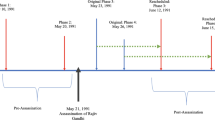Abstract
We examine equilibrium voting strategies for elections with interested politicians facing uncertainty about voter pReferences. If politicians' utilities are defined over the set of strategies that voters select (instead of being dependent only on the probability of winning an election), equilibrium strategies will diverge (instead of converging to the median voter's pReferences) as long as politicians have different pReferences. We present conditions (i) for political compromise, and (ii) for politicians with different utility functions to merge into parties with complete strategic agreement.
Similar content being viewed by others
References
Aldrich, J. (1983). A Downsian spatial model with party activism. American Political Science Review, forthcoming.
Aranson, P.H., and Ordeshook, P.C. (1972). Spatial strategies for sequential elections. In Niemi and Weisberg (Eds.), Probability models of collective decision making. Columbus, Ohio: Merrill.
Aranson, P.H., and Ordeshook, P.C. (1981). Regulation, redistribution, and public choice. Public Choice 37: 69–100.
Coleman, J. (1972). The positions of political parties in elections. In Niemi and Weisberg (Eds.), Probability models of collective decision making. Columbus, Ohio: Merrill.
Downs, A. (1957). An economic theory of democracy. New York: Harper and Row.
Hinich, M.J., Ledyard, J.O., and Ordeshook, P.C. (1973). A theory of electoral equilibrium: A ‘spatial’ analysis based on the theory of games. Journal of Politics 35: 154–193.
Hinich, M.J., Ledyard, J.O., and Ordeshook, P.C. (1972). Non-voting and the existence of equilibrium under majority rule. Journal of Economic Theory 4: 144–153.
Hotelling, H. (1929). Stability in competition. Economic Journal 39: 41–57.
Riker, W.H., and Ordeshook, P.C. (1973). An introduction to positive political theory. Englewood Cliffs, N.J.: Prentice-Hall.
Rosen, J.B. (1965). Existence and uniqueness of equilibrium points for concave n-person games. Econometrica 33: 520–534.
Wittman, D. (1973). Parties as utility maximizers. American Political Science Review 63: 490–498.
Wittman, D. (1977). Candidates with policy pReferences: A dynamic model. Journal of Economic Theory 14: 180–189.
Author information
Authors and Affiliations
Additional information
Thanks are due to Peter Aranson, Mark Feldman, and a referee. The research support of the Bank of Sweden Tercentenary Foundation is gratefully acknowledged.
Rights and permissions
About this article
Cite this article
Hansson, I., Stuart, C. Voting competitions with interested politicians: Platforms do not converge to the preferences of the median voter. Public Choice 44, 431–441 (1984). https://doi.org/10.1007/BF00119691
Issue Date:
DOI: https://doi.org/10.1007/BF00119691




